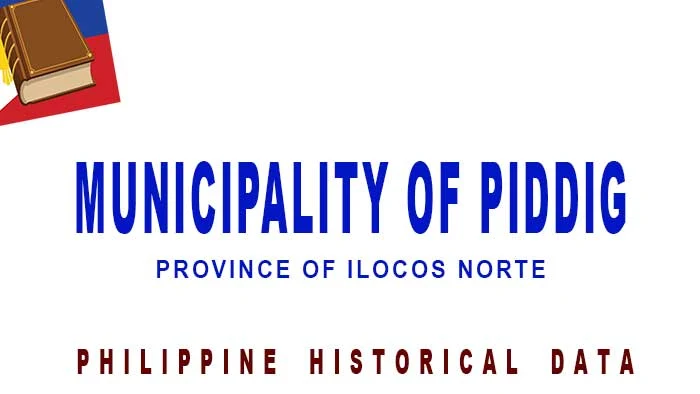MUNICIPALITY OF PIDDIG, Historical Data
[Cover page]
PIDDIG
[p. 1]
PIDDIG
Piddig is located at the eastern part of Ilocos Norte. It is seventeen kilometers from Laoag, the provincial capital. The poblacion is on a hill which is approximately one hundred meters above sea level. The town is generally highland with several intervening lowlands.
The town has a population of 11,755. The people speak the Ilocano dialect [more correctly, language] but differ in their intonations. The people, as a whole, are sturdy, peaceful and industrious.
The forests within the jurisdiction of Piddig are productive. Much lumber, rattan, nito and cogon grass are taken from them. Most of them provide good hunting grounds. In the mountains of Piddig, there are also deposits of gold, manganese, silver, and lead. Some claims for these mines have been made and registered. Among these places where these mineral resources are found are Carasi, Madariwara, Bantay Guisit, Bantay Cura, Balak Wak. The town is surrounded by two rivers, namely, Guisit River and Paluyan River. These rivers are the sources of fish supplies for the people of Piddig.
ORIGIN OF THE TOWN
[p. 2]
EARLY INHABITANTS
CHURCHES
There are three churches in Piddig, namely, the Roman Catholic Church, the Philippine Independent Church, and the Protestant Church. Christianization was begun by the Augustinian missionary priests who were residing in Dingras. In 1730, Fr. Manuel Madariaga came to live in this town. The people were easily converted due to the great zeal of the missionaries. The early civilization of the inhabitants was contributed by the Roman Catholic Church. The church and the convent are living relics of the exacting Spanish rulers and the hard labor of the people in those days. The church is one of the biggest churches in Ilocos Norte.
A new sect was organized in 1902 by Mons. Gregorio Aglipay, with the cooperation of Rev. Jose Castro, who became Piddig's first priest of the Philippine Independent Church. Almost all the people of the town pledged their faith and became followers of the new church. The Protestant sect was spread in the town in 1905 by the American missionary, Mr. William H. Hanna. The first pastor was Rev. Esteban Salmon, who carried on the ministry work with conside-
[p. 3]
rable success.
EDUCATION
INDUSTRIES
MODERN IMPROVEMENTS
[p. 4]
a hill on the western part of the town. From its second floor, one can enjoy a panoramic view of the town and the picturesque scenery of the outlying fields and rivers with the seemingly endless mountains as background. This was burned on December 4, 1944.
The outstanding achievement of the present administration is the improvement of the public market, which is located in the heart of the town. The floor was made concrete in 1932. It can accommodate comfortably about five hundred people. In the absence of spacious halls, it is often rented for social activities. With the civic spirit that the members of the "Young Hawaiian Organization" has, they erected the Rizal Monument in December 1933. It was worth ₱1,000 and is conspicuously located on the plaza. Another noteworthy improvement done lately is the modernization of the culverts by President Hernaez.
Other recent improvements are the theater located at the northeastern part of the plaza, [and] the reconstructed Central School under the Philippine Rehabilitation Act. There is also an amphitheather in front of the Piddig Central School Building No. 2 and a standard Home Economics Building.

